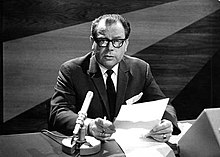74:
70:"Where they are not, nothing is happening" was the motto of the cameramen of Polygoon who traveled up and down the Dutch countryside to capture news and local culture. There was a lot of competition at that time from other companies like Profilti and Haghefilm. Contracts for sport events, cameramen trying to cheat each other or fighting, aggressive sales methods and vague acquisitions were common.
31:
62:
The company was founded in 1919 and then made in-between movies for the silent movies of that time. Starting from 1921, it made ordered custom movies like 'the winning of brown coal "Carisborg"' (name translated) or 'Steam wheat mill "Holland" in
Amsterdam' (name translated). Then in 1924 it started
103:(1918–1999) started as commentator; his particular voice became synonymous with Polygoon. Because of the emergence of the television in the Netherlands by the late 1950s, the Polygoon journals lost much attention, but the service lasted until 1987 before it finally ended.
35:
106:
Cameramen employed by
Polygoon had orders to fill their reels, no matter what. If not for news, then with the local celebrity or even shots of famous buildings or locations. Because of this, Polygoon's archive is now a valuable source of historical
32:
34:
33:
144:
112:
124:
169:
17:
59:
movie theaters and lasted until 1987 when it finally surrendered to television news shows.
8:
164:
127:
the first visiting team to play against
Hilversum in 1958, filmed by Polygoon at the
100:
81:
128:
91:, the Polygoon-journal had its glory days; 400 different cinemas weekly showed
56:
158:
108:
88:
111:
available for other productions. It is currently being digitalized by the
52:
149:
132:
116:
73:
48:
120:
55:
from 1919 to 1987. It started with weekly news items in the
119:. Several Polygoon newsreels can also be found on
156:
150:selection of Polygoon newsreels viewable online
145:The Netherlands Institute for Sound and Vision
113:Netherlands Institute for Sound and Vision
67:, first bi-weekly, from the 1930s weekly.
27:Cinema newsreel company in the Netherlands
39:Images of a new polder in the Netherlands
72:
29:
14:
157:
123:. One such example is the arrival of
24:
25:
181:
138:
80:voice of the Polygoon-journal,
13:
1:
7:
10:
186:
125:Thomas Cook's Rugby Club
45:Dutch Polygoon-Profilti
99:. In 1946, the editor
84:
40:
76:
63:with cinema newsreel
38:
85:
41:
101:Philip Bloemendal
82:Philip Bloemendal
36:
16:(Redirected from
177:
93:Neêrlands Nieuws
37:
21:
185:
184:
180:
179:
178:
176:
175:
174:
170:History of film
155:
154:
141:
129:AGOVV Apeldoorn
65:Hollands Nieuws
51:company in the
30:
28:
23:
22:
15:
12:
11:
5:
183:
173:
172:
167:
153:
152:
147:
140:
139:External links
137:
26:
9:
6:
4:
3:
2:
182:
171:
168:
166:
163:
162:
160:
151:
148:
146:
143:
142:
136:
134:
130:
126:
122:
118:
114:
110:
109:stock footage
104:
102:
98:
94:
90:
83:
79:
75:
71:
68:
66:
60:
58:
54:
50:
47:was a cinema
46:
19:
105:
97:Wereldnieuws
96:
92:
89:World War II
86:
77:
69:
64:
61:
44:
42:
131:stadium in
115:located in
53:Netherlands
159:Categories
165:Newsreels
133:Apeldoorn
117:Hilversum
49:newsreel
18:Polygoon
121:YouTube
87:After
57:Dutch
95:and
43:The
78:The
161::
135:.
20:)
Text is available under the Creative Commons Attribution-ShareAlike License. Additional terms may apply.
